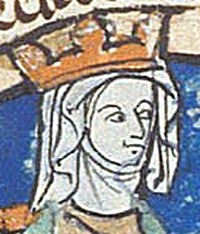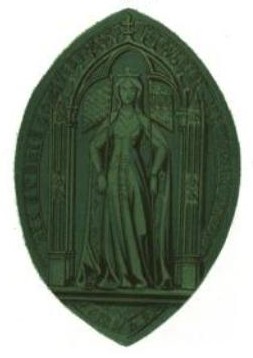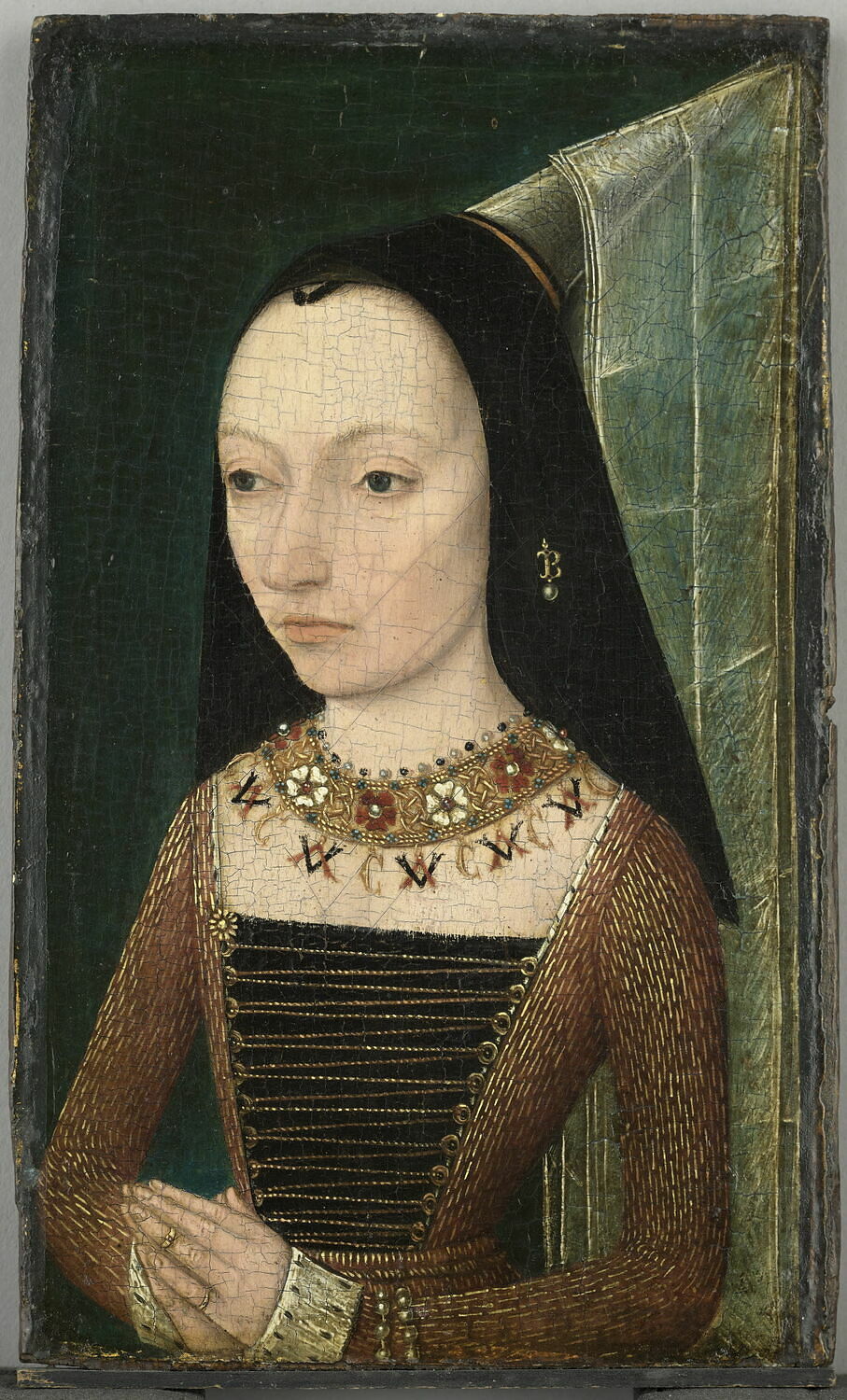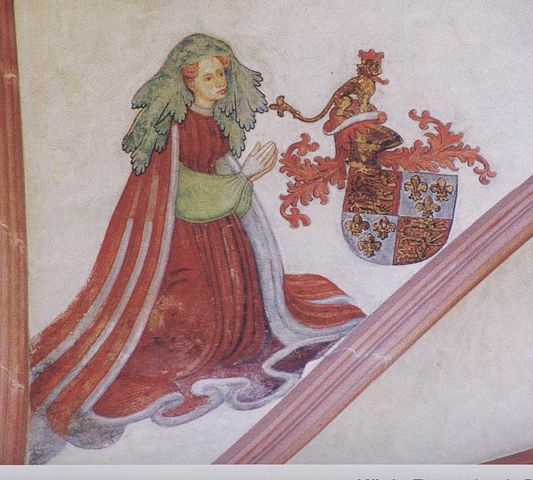April 30, 1383 birth of Anne of Gloucester, a granddaughter of Edward III.
Anne was the daughter of Thomas of Woodstock, 1st Earl of Gloucester. Thomas was the youngest son of Edward. Her mother was Eleanor de Bohun. Eleanor was the daughter of Humphrey, 7th earl of Hereford and Joan Fitzalan. Eleanor had been named for her maternal grandmother Eleanor of Lancaster, who was a granddaughter of Edmund Crouchback (son of Henry III). Eleanor was co-heiress to Humphrey's estate with her sister Mary. While Eleanor had married Thomas, her sister Mary was married to Thomas' nephew Henry Bollingsbrook (son of his brother John of Gaunt) the future Henry IV. Thomas had actually tried to make Mary become a nun, to ensure Eleanor inherited the entire estate, but his brother John got her married off to his son instead.
Eleanor and Thomas had five children. Anne's siblings:
-Humphrey, 2nd Earl of Buckingham-after the murder of Thomas, he was taken into the custody of Richard II along with the future Henry V. They were left in Ireland when Richard II went back to face Humphrey's Uncle Henry Bollingsbroke. After Richard was deposed, Henry summoned both his son and nephew Humphrey home. Unfortunately Humphrey was ill and died on the route back. His mother is said to have died of sorrow shortly after. He was only 18 at the time.
-Joan: was married to Gilbert Talbot, 5th lord Talbot. She died in childbirth at 16 years old. No living children.
-Isabel-became a nun.
-Philippa- date of death is unknown but she died young.
Anne was baptized in Pleshey Essex in May. Her Uncle John of Gaunt had been made to pay for the baptism. At 16 she became co-heiress to her father's estate when her brother died. She became soul heiress in 1400 as Joan had died and Isabel had taken her vows as a nun. She was Countess of Buckingham, Hereford and Northampton as well as Lady of Brecknock and Holdernes. Anne though opted never to use her titles, instead using those of her husband.
Her first marriage was to Thomas Stafford, 3rd Earl of Stafford. Thomas was the second son of the 2nd Earl of Stafford. His father had died in 1386, and his older brother Ralph the year before. Thomas of Woodstock took guardianship of Thomas' three younger brothers, while Thomas Stafford entered his service (he was knighted and went on campaign). William was 11, Edmund was 9 and Hugh was 4. Their mother had died the same year as their father. He had actually left on a trip to the Holy land after her death, in mourning, but died in Rhodes. Thomas was 20, and Anne was 7 when they were married in 1390, but her husband died 2 years later.
William who remained in the custody of Thomas, became the knew Earl. But he died three years after his brother. He was succeeded by his brother Edmund. Thomas of Woodstock married Anne to her former brother in law Edmund in 1398. They needed a special license due to her first marriage to his brother. But due to her age, her first marriage was not consummated so the license was given. This time Anne was 15 and her husband was 21, only 6 years older then his bride (unlike his brother who had been 13 years).
Unfortunately for Anne, Edmund was only slightly longer lived then his brothers, dying in 1403 at the age of 25. Unlike his brothers, he left heirs.
Humphrey- inherited his mother's titles, and in 1444 was created Duke of Buckingham. He was married to Lady Anne Neville. Anne was the daughter of Ralph Neville, 1st Earl of Westmoreland and his 2nd wife Joan. Anne was a granddaughter of John of Gaunt, her mother was his daughter by his third wife Katheryn. Ralph Neville's first wife had been Humphrey's paternal Aunt Margaret Stafford (older sister of Edmund and Thomas).
Anne- married Edmund Mortimer, 5th Earl of March. Edmund was a great-grandson of Lionel of Antwerp. Their marriage was childless. Her second marriage was to John Holland, 2nd Duke of Exeter. Anne was the first of John's three wives and bore him his heir Henry as well as a daughter Anne. Henry would marry Anne of York (sister of Edward IV and Richard III). Anne married three times, but only had a child by her second husband. Her second husband Ralph was her relative. Ralph's maternal grandmother was Margaret Stafford. They had one son Ralph who was 3rd Earl of Westmoreland and gave her two grandchildren.
Philippa- died young.
After the death of Edmund in 1403 fighting with the king at the Battle of Shrewsbury, Anne would marry a third time. Her third husband was William Bourchier, 1st Count of Eu. He was an English knight who had been created Count of Eu by Henry V. They married in 1405 when she was 22 years old and her groom was 31. This marriage would last for 15 years before her husband died in 1420.
During her marriage to William she had 5 children:
-Henry: he inherited the title Baron Bouchier from a cousin in 1433, and was raised to Viscount in 1446. He was made 1st Earl of Exeter in 1461. He married Isabel of Cambridge, a daughter of the 3rd Earl of Cambridge. Her father was the son of Edmund, Duke of York (4th son of Edward III). Isabel's brother Richard was the father of Richard III and Edward IV. The couple had 11 children. Their eldest son William would marry Anne Woodville, a younger sister of Queen Elizabeth Woodville.
-Eleanor: married John Mowbray, 3rd Duke of Norfolk. The couple were said to have married for love (known for going off to have romantic trysts together). They had one son John who inherited the title when his dad died when he was 17. John married Elizabeth Talbott but the duchy became extinct on John's death, though the Earldom was inherited by Eleanor's granddaughter Anne. Anne unfortunately died at 9, married to Richard of York (one of the princes in the tower).
-William: was 9th baron Fitzwarin. He married twice. His first wife Thomasine Hankford was a co-heiress of Sir Richard Hankford. Her mother Elizabeth had been the 8th baroness, and William became Baron Fitzwarin through their marriage. They inherited part of her father's estate as well as her father had a child from a second marriage to inherited part. Thomasine bore him two children. Their son Fulk succeeded as 10th baron, and had 3 children, one of whom became the 1st Earl of Bath. Fulk's daughter Elizabeth was the mother of Anne Stanhope, sister in law of Jane Seymour. They also had a daughter Blanche. William's second marriage was to Catherine de Affeton, an heiress as well, with whom he had no children.
-Thomas: was Bishop of Wincester and later Ely before serving as Archbishop of Canterbury. He was made a cardinal in 1467. He crowned three kings: Edward IV, Richard III and Henry VII.
-John: In 1455 he was made Baron Berners. He was constable of Windsor castle from 1461-1474. His title came from his wife's family name, having married Margery, the daughter of Sir Richard Berners. The couple had 2 children. His son Humphrey died before him so his grandson John succeeded him. Humphrey's had 3 children with his wife Elizabeth Tilney, who later went on to marry Thomas Howard, 2nd duke of Norfolk. John, 2nd Baron Berners was half-brother of Edmund (Katherine Howard's father) and Elizabeth (mother of Anne and Mary Boelyn, grandmother of Elizabeth I). John (1st Baron) and Margery's daughter married Sir Henry Neville with whom she had three kids.
Anne died 18 years after her third husband, in 1438. She was buried at
https://en.wikipedia.org/wiki/Llanthony_Secunda_Priory


 So Stephen had no link, but if he had been succeeded by one of his sons, his son would have carried the ancient blood. Of their five children, only one had any children though. Their daughter Marie who had once been a nun until after the death of her brothers, had 2 daughters both who had kids.
So Stephen had no link, but if he had been succeeded by one of his sons, his son would have carried the ancient blood. Of their five children, only one had any children though. Their daughter Marie who had once been a nun until after the death of her brothers, had 2 daughters both who had kids.

